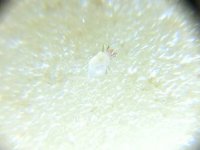Update: I have no more mites in the rootzone! Here's what they looked like under scope: http://www.youtube.com/watch?v=1_Sa7x1AxeU
My hypothesis is that they were indeed fungus/mold/bacteria feeders. And nothing would kill them. I made a ACT(aerated compst tea) and drenched and added to res. Under a scope I noticed that the tea not only had a diverse microganisms but also free living nematodes, which also feed on fungus/etc. Seems the nems along w everything elase created their own ecosystem that eliminated the mites. Crazy. Now I am innoculating w tea but not running in res. I used the progress earth 3 part brew your own tea mix and added mycorrhizae. Stuff rocks!
My hypothesis is that they were indeed fungus/mold/bacteria feeders. And nothing would kill them. I made a ACT(aerated compst tea) and drenched and added to res. Under a scope I noticed that the tea not only had a diverse microganisms but also free living nematodes, which also feed on fungus/etc. Seems the nems along w everything elase created their own ecosystem that eliminated the mites. Crazy. Now I am innoculating w tea but not running in res. I used the progress earth 3 part brew your own tea mix and added mycorrhizae. Stuff rocks!





